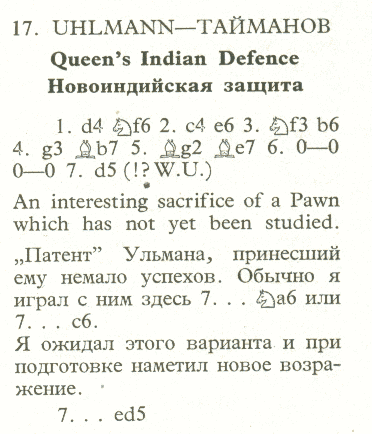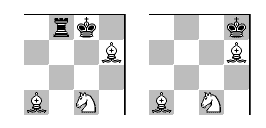The USSR -v- The Rest of the World 1970.
Historic match. Fischer stepped down and played board 2 to Larsen.
Larsen loses that famous1.b3 game to Spassky.
The result was USSR 20½ Rest of The World 19½
A lot closer than people anticipated.
Fischer was none too chuffed with Portisch for agreeing a draw with
Korchnoi when Portisch had a technically won game.
You would think a book about the event with the games annotated
by all the players would be a good buy and a worthy publication.
There is one!

I found it whilst browsing through the Edinburgh Chess Club’s library
of 3,000 odd chess books. (I was looking for something I had not read!) 🙂
One wee itsy bitsy problem.
The names of the ROW players are in English.
The names of the USSR players are in Russian.
The name of the opening is in both languages.
The notes of the ROW players are in English.
The notes of the USSR players are in Russian.
I kid you not.

How odd is that?
The notes from one half of the players cannot be read unless you
are clever enough to be versed in both languages.
It needs translating.
The Russian into English and the English into Russian.
Then no matter what your persuasion you can follow the games
with both sets of notes.
Of course you will need to get the both books to understand all the notes.
(One book the left side of the board and one book for the right side of the board.)
A brilliant concept. Two books covering the one tournament!
A marketing trick the major chess publishing houses have yet to pull…
….give them time.

Continuing with the theme of Mating Patterns and this week it’s Blackburne’s Mate.
This a double Mating Pattern carried out by the three minor pieces.
Two Bishops and a Knight mate against a castled King. It looks like this.

Technical Jargon Explanation No.210
Queens and Rooks are often called the major pieces. The Bishops
and Knights are called the minor pieces.
This give me a an excuse to show one of my favourite games.
Every chess player should be acquainted with this game.
Amateur - Blackburne, England 1880
Two good examples from RHP. Both with Black.
First we see the Scholars Mate equivalent of the Blackburne Mate.
Positional Player - iMD RHP 2006
Next, I have no hesitation in showing this game on the same page as Blackburne’s.
masterpiece. It is a nigh perfect compliment.
Weadley - LightWarrrior RHP 2006.
So back here.
I was saying the Blackburne Mate still lurks but if White plays 1.cxb7+
and Black still goes for it the then the refutation is instructive.
I found this, another Black win!
Not exactly a Blackburne mate, It’s a standard mate with a Knight and Bishop.
The plausible build up to it make it a worthy example.
bobbymunro - Mad Mac MacMad RHP 2008
And as always we end with a humorous closer.
Could do a book of these. ‘Jokes on the Chessboard.’ featuring everyone.
Black wins the White Queen.
“No it was sacrifice shouts back Ravello.”
OK White er….sacs his Queen for two Knights and…..
No I won’t spoil the ending for you.
Ravello - jMbernZ RHP.2005
Historic match. Fischer stepped down and played board 2 to Larsen.
Larsen loses that famous1.b3 game to Spassky.
The result was USSR 20½ Rest of The World 19½
A lot closer than people anticipated.
Fischer was none too chuffed with Portisch for agreeing a draw with
Korchnoi when Portisch had a technically won game.
You would think a book about the event with the games annotated
by all the players would be a good buy and a worthy publication.
There is one!

I found it whilst browsing through the Edinburgh Chess Club’s library
of 3,000 odd chess books. (I was looking for something I had not read!) 🙂
One wee itsy bitsy problem.
The names of the ROW players are in English.
The names of the USSR players are in Russian.
The name of the opening is in both languages.
The notes of the ROW players are in English.
The notes of the USSR players are in Russian.
I kid you not.

How odd is that?
The notes from one half of the players cannot be read unless you
are clever enough to be versed in both languages.
It needs translating.
The Russian into English and the English into Russian.
Then no matter what your persuasion you can follow the games
with both sets of notes.
Of course you will need to get the both books to understand all the notes.
(One book the left side of the board and one book for the right side of the board.)
A brilliant concept. Two books covering the one tournament!
A marketing trick the major chess publishing houses have yet to pull…
….give them time.

Continuing with the theme of Mating Patterns and this week it’s Blackburne’s Mate.
This a double Mating Pattern carried out by the three minor pieces.
Two Bishops and a Knight mate against a castled King. It looks like this.

Technical Jargon Explanation No.210
Queens and Rooks are often called the major pieces. The Bishops
and Knights are called the minor pieces.
This give me a an excuse to show one of my favourite games.
Every chess player should be acquainted with this game.
Amateur - Blackburne, England 1880
Two good examples from RHP. Both with Black.
First we see the Scholars Mate equivalent of the Blackburne Mate.
Positional Player - iMD RHP 2006
Next, I have no hesitation in showing this game on the same page as Blackburne’s.
masterpiece. It is a nigh perfect compliment.
Weadley - LightWarrrior RHP 2006.
So back here.
I was saying the Blackburne Mate still lurks but if White plays 1.cxb7+
and Black still goes for it the then the refutation is instructive.
I found this, another Black win!
Not exactly a Blackburne mate, It’s a standard mate with a Knight and Bishop.
The plausible build up to it make it a worthy example.
bobbymunro - Mad Mac MacMad RHP 2008
And as always we end with a humorous closer.
Could do a book of these. ‘Jokes on the Chessboard.’ featuring everyone.
Black wins the White Queen.
“No it was sacrifice shouts back Ravello.”
OK White er….sacs his Queen for two Knights and…..
No I won’t spoil the ending for you.
Ravello - jMbernZ RHP.2005

